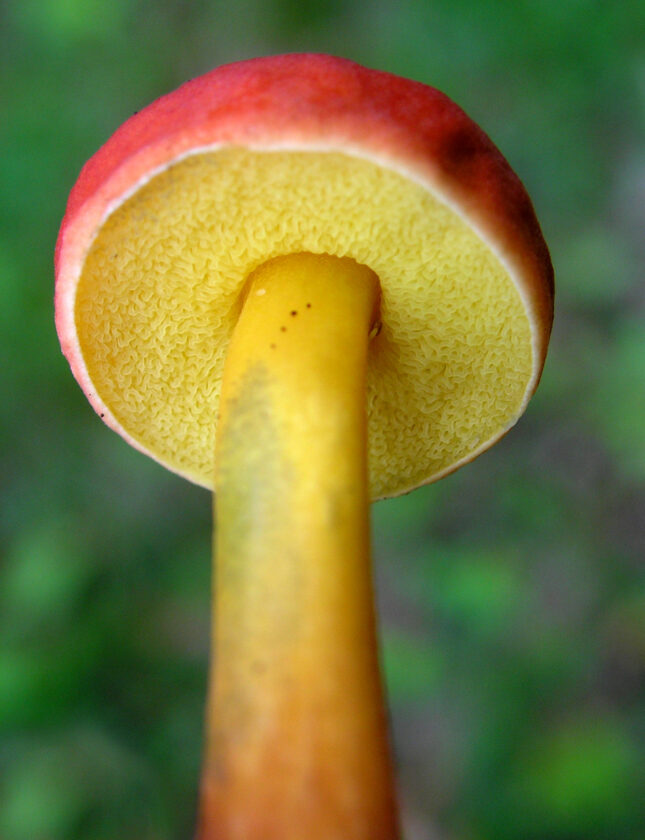‘New finds await’: Field guide updates record of Kansas mushrooms

photo by: Hank Guarisco
Sherry Kay wrote "A New Guide to Kansas Mushrooms" with co-authors Benjamin Sikes and Caleb Morse
As a girl hunting puffballs with her mother in south central Kansas, Sherry Kay never planned to write the comprehensive guidebook to mushrooms in her home state. “I just liked being outside, enjoyed mushrooms and enjoyed learning about things,” said Kay of how she found her lifelong avocation. “And mushrooms don’t move.”
Six years in the making, Kay’s New Guide to Kansas Mushrooms (University Press of Kansas), co-authored by Benjamin Sikes and Caleb Morse, launched in October to a packed house at the Lawrence Public Library. The book updates a 1993 guidebook by Bruce Horn, Dean Abel, and Kay’s husband, Richard “Skip” Kay, who died in 2018. The revolution in gene sequencing rendered many species names and groupings in the original book obsolete, and the number of known species in Kansas has nearly doubled since its publication, from 727 to over 1,200.

photo by: Contributed
Hortiboletus fraternus
The new book features revisions of 150 species descriptions, along with 50 new species, some of which represent fungi families not included in the previous edition. Some common lawn mushrooms (for the “frantic parents of mycophilic offspring,” a preface notes), and mushrooms unusual to Kansas are new, along with colorful photographs by Carla Wick and Hank Guarisco. Kay says she and her co-authors designed the book to be used by anyone interested in learning more about mushrooms, from novices to experts.
Kay was a novice herself 50 years ago when she, her husband and some friends took field mycology courses offered by Kansas University professor Robert Lichtwardt, and, after many a mushrooming foray in the woods and fields of Douglas County, formed the Kaw Valley Mycological Society in 1986. The organization still meets regularly to hunt for mushrooms, and its members provide specimens for preservation and use by researchers at KU’s R.L. McGregor Herbarium, where New Guide co-author Caleb Morse manages a collection including some 50,000 fungi.
The first edition of the guide went out of print in 2017, but with copies fetching prices in the hundreds online, plans for a revision were underway. When Richard Kay died, the mantle passed to his widow, Sherry.

photo by: Phil Cauthon
Sherry and Richard Kay of the Kaw Valley Mycological Society.
“When Skip died, it was a low point,” she says. “But working on the new book kept me from mourning, a bit. It helped me get through it.”
Over the years Kay had discovered specimens in Kansas from a number of families not included in the original book, and says she “had been collecting ideas in the back of my mind of things to add” to a new edition. Benjamin Sikes, an associate professor and scientist of microbial ecology at the University of Kansas, was enlisted to help bring the identifications up to date and construct cladograms, the book’s extensive diagrams charting how species relate to one another. Morse helped write the book’s keys — flowchart-like sets of questions used to identify specimens — and index.
“I knew them both before working on the book,” Kay says gratefully of her co-authors. “Really kind, good people with too much to do already in their own lives. They should be proud of how the book turned out.”
“Sherry is a top notch field mycologist, and gave a lot of input on what mushroom characters were useful for the keys,” Morse says. He thinks the book compares well to other regional field guides of its type, and weighs its merits against popular online identification tools. “Inaturalist is pretty good with vascular plants, but not so great with fungi, which you need to look at in a different way, sometimes using smell and taste, too.”
Kay agrees mushroomers need to rely on more than just photographs to identify species. “People need to read the text and key it out,” she says, “and with the book they can really go through the motions of learning to identify a mushroom.”
One obvious reason why is that some Kansas mushrooms can be toxic to humans. Kay is upfront about the dangers (“You can kill yourself eating them”), but is quick to point out there are more poisonous plants than mushrooms. “This culture is basically mycophobic,” she says, “but we are just starting to get interested.” For those who already are, the book has a section on cooking with mushrooms, and species descriptions include notes about edibility and flavor.

photo by: Hank Guarisco
Amanita populiphila
Inedible species won’t end up on the dinner table, but mushroomers can record them in another part of the book, a comprehensive life checklist of species. Sherry Kay’s personal life list tops 1,200, but she doesn’t recommend consciously hunting for elusive mushrooms. “I do sometimes say I’m going to find this, or I’m going to find that, and I never find what I’m actually looking for. But I always find something.”
Locally, Martin Park in northwest Lawrence, or any trails along the river are good places to look for mushrooms, according to Kay. Yards in town can also be productive, although she reminds mushroomers always to ask homeowners before picking, and to remember that mushrooms absorb chemicals from substrates where pesticides or herbicides have been used.
As Kay notes in the New Guide, estimates of the number of macrofungi worldwide range from 30,000 to 35,000, many more of which she believes could be found in Kansas, including the possibility of species new to science.
“Every time I foray, I see mushrooms I cannot identify,” she writes. “New finds await.”

photo by: Hank Guarisco
Gymnopus luxurians

photo by: Sherry Kay
Hymenopellis radicata

photo by: Sherry Kay
Morchella americana

photo by: Sherry Kay
Lysurus perphragmoides








